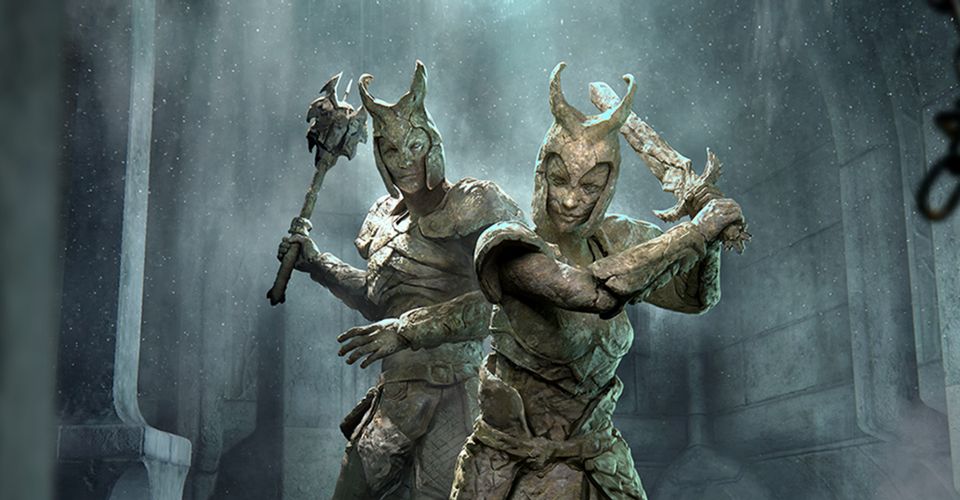Elder Scrolls: Why Did The Ayleid Elves Disappear?

The full history of The Elder Scrolls and its primary continent of Tamriel involves the rise and fall of many cultures and civilizations, including the Ayleid, a race of Elves that established the first Tamrielic empire. The Ayleid Empire was responsible for building the White-Gold Tower in what would later become The Elder Scrolls‘ Imperial City, and their influence extended throughout Cyrodiil. Though the Ayleids were once powerful, their civilization existed during the earliest period of recorded history in Tamriel, and by the time any of the mainline Elder Scrolls games take place, that particular race of elves had essentially disappeared.
The first four games in the series – Arena, Daggerfall, Morrowind, and Oblivion – take place near the end of the Third Era, a period of Tamrielic history which consisted entirely of the Septim Dynasty’s rule over the Third Empire. The Elder Scrolls V: Skyrim uniquely takes place in the Fourth Era, roughly two centuries after Oblivion, where the Third Empire is ruled by The Elder Scrolls’ declining Mede Dynasty. The founding of the Ayleid Empire, however, took place approximately 4,200 years prior to the events of Arena and coincided with the beginning of the First Era. Oddly, the Ayleid Empire is not the reason for declaration of the First Era, which is instead officially marked by the founding of the Camoran Dynasty in Valenwood, the province to Cyrodiil’s southwest.
Though the Camoran Dynasty may be more important to Tamriel historiographically, the Ayleid Empire has a much greater impact on the mainline Elder Scrolls series, particularly Oblivion. Ruins of the Ayleid’s civilization can be seen all over the province, usually constructed out of a white stone, and typically delving underground. Much like the structures of the Dwemer, whose ruins can be see frequently in Skyrim, crumbling Ayleid buildings often play host to quests in Oblivion. Furthermore, there’s an argument to be made that the Ayleid Empire plays a more important role culturally, since its downfall directly contributes to Men usurping Elves as the dominant political racial category in Tamriel, despite the Wood Elf-ruled Camoran Dynasty surviving until the Third Era.
Rise Of The Elder Scrolls’ Ayleid Empire

In the midst of the Merethic Era, which spans approximately 2,500 years in Tamriel before the Empire of The Elder Scrolls and the beginning of the First Era, Ayleid settlers left the Summerset Isles and sailed for the mainland. The Ayleids settled primarily in Cyrodiil, but there is evidence of early Ayleid settlements in High Rock far to the northwest, and others went beyond Cyodiil to Black Marsh in the southeast. Among other cultural reasons, the Ayleids migrated so that they could freely worship the Daedra, a practice disallowed by the Aldmeri civilization in Summerset. It was at some point during the Middle Merethic Era that the Temple of the Ancestors was constructed, built to mimic the oldest structure in Tamriel, the Adamantine Tower in High Rock, which is powerfully magical and of unknown origin.
The Temple of the Ancestors is the single greatest monument to the Ayleid Empire since it still stands, having been renamed White-Gold Tower. Centuries later it is still of tremendous political import as the location of the Third Empire’s Ruby Throne, played host to the signing of the White-Gold Concordat prior to Skyrim, and served as housing for the Elder Scrolls themselves. With the Temple of the Ancestors marking the Ayleids’ seat of power, their empire grew in tandem with the rise of Daedric worship. Far from the influence of the Aldmer on the Summerset Isles, scattered Ayleid clans flourished and eventually consolidated into an empire, conquering all of Cyrodiil and enslaving the Nordic Men therein.
At its height, the Ayleid Empire spanned a great distance, with settlements in at least six of Tamriel’s nine provinces – Cyrodiil, Black Marsh, Elsweyr, Hammerfell, High Rock, and Valenwood. The Ayleid culture was intensely magical, supposedly obsessed with the number eight, and responsible for creating the Welkynd Stones which can be found throughout Cyrodiil in Oblivion. Much of their magical prowess came from widespread worship of The Elder Scrolls’ Daedric Princes. Veneration of all Princes contributed greatly to the Ayleid Empire’s expansion, where Daedra were used to conquer, subjugate, and enslave. This would, however, directly contribute to the downfall of the Empire, and the ultimate disappearance of the Ayleids.
Fall Of The Ayleid Empire & Their Disappearance

The Ayleid Empire made an art form of torture. Those who were not Elven were enslaved, and where the more heinous Daedric Princes were worshipped, the more heinous the torture of the enslaved. According to an in-game book titled “The Adabal-a,” believed to be written by a demigod named Morihaus, the Ayleids had many refined forms of torture, including “wailing wheels,” “gut gardens,” “flesh sculpture,” and something referred to as “tiger sport” in which “children were set aflame.” This indulgently violent treatment of slaves resulted in a rebellion which would topple the Ayleid Empire.
Morihaus is believed to be the consort of Alessia the Slave Queen, who led the enslaved in the uprising against the Ayleids. She was granted three visions by the Aedra at Sancre Tor, a place which would become sacred for generations, and be the location at which General Talos won a decisive victory and secured the Amulet of Kings at the founding of the Elder Scrolls Septim Dynasty near the beginning of the Third Era. Alessia established a holy city at Sancre Tor, and began her rebellion, eventually capturing the Temple of the Ancestors in the 243rd year of the First Era. The Temple of the Ancestors, which would become the White-Gold Tower, now held the throne of the Alessian Empire. Conflicts with the Ayleids would continue for centuries following establishment of the Alessian Empire, and Alessia herself would be canonized as a saint upon her death.
The fall of the Temple of the Ancestors marked the beginning of the end for the Ayleids in Tamriel. The age of Men had begun, and Alessia established the Eight Divines, supposedly an amalgamation of religious beliefs of the formerly enslaved Nords and dissatisfied Ayleid lords who joined Alessia in overthrowing the Ayleid Empire. The Eight Divines would become The Elder Scrolls‘ primary pantheon, with the ascension of General Talos to godhood creating Ninth Divine. Slowly, the remaining Ayleid populations faded, and there were mass exoduses of Ayleids from Cyrodiil following the rise of the Alessian Empire. Many Ayleids likely assimilated into other Elven cultures, particularly the Direnni Hegemony which ruled High Rock. By the time Oblivion takes place in the late Third Era, there are no Ayleids to be found in Cyrodiil, though rumors throughout The Elder Scrolls games claim there are still nomadic tribes of Ayleids living hermitically in the forests of Tamriel.
About The Author

















